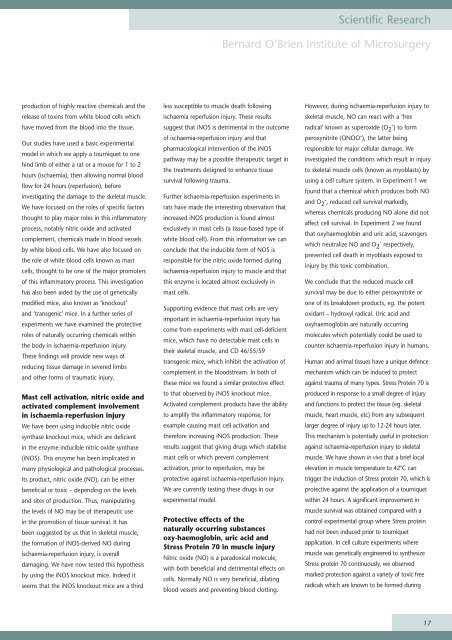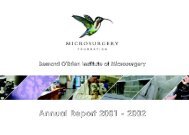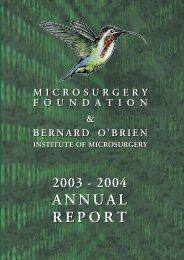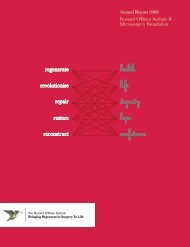2990 Microsurgery.qxd - O'Brien Institute
2990 Microsurgery.qxd - O'Brien Institute
2990 Microsurgery.qxd - O'Brien Institute
You also want an ePaper? Increase the reach of your titles
YUMPU automatically turns print PDFs into web optimized ePapers that Google loves.
Scientific Research<br />
Bernard O’Brien <strong>Institute</strong> of <strong>Microsurgery</strong><br />
production of highly reactive chemicals and the<br />
release of toxins from white blood cells which<br />
have moved from the blood into the tissue.<br />
Our studies have used a basic experimental<br />
model in which we apply a tourniquet to one<br />
hind limb of either a rat or a mouse for 1 to 2<br />
hours (ischaemia), then allowing normal blood<br />
flow for 24 hours (reperfusion), before<br />
investigating the damage to the skeletal muscle.<br />
We have focused on the roles of specific factors<br />
thought to play major roles in this inflammatory<br />
process, notably nitric oxide and activated<br />
complement, chemicals made in blood vessels<br />
by white blood cells. We have also focused on<br />
the role of white blood cells known as mast<br />
cells, thought to be one of the major promoters<br />
of this inflammatory process. This investigation<br />
has also been aided by the use of genetically<br />
modified mice, also known as ‘knockout’<br />
and ‘transgenic’ mice. In a further series of<br />
experiments we have examined the protective<br />
roles of naturally occurring chemicals within<br />
the body in ischaemia-reperfusion injury.<br />
These findings will provide new ways of<br />
reducing tissue damage in severed limbs<br />
and other forms of traumatic injury.<br />
Mast cell activation, nitric oxide and<br />
activated complement involvement<br />
in ischaemia-reperfusion injury<br />
We have been using inducible nitric oxide<br />
synthase knockout mice, which are deficient<br />
in the enzyme inducible nitric oxide synthase<br />
(iNOS). This enzyme has been implicated in<br />
many physiological and pathological processes.<br />
Its product, nitric oxide (NO), can be either<br />
beneficial or toxic – depending on the levels<br />
and sites of production. Thus, manipulating<br />
the levels of NO may be of therapeutic use<br />
in the promotion of tissue survival. It has<br />
been suggested by us that in skeletal muscle,<br />
the formation of iNOS-derived NO during<br />
ischaemia-reperfusion injury, is overall<br />
damaging. We have now tested this hypothesis<br />
by using the iNOS knockout mice. Indeed it<br />
seems that the iNOS knockout mice are a third<br />
less susceptible to muscle death following<br />
ischaemia reperfusion injury. These results<br />
suggest that iNOS is detrimental in the outcome<br />
of ischaemia-reperfusion injury and that<br />
pharmacological intervention of the iNOS<br />
pathway may be a possible therapeutic target in<br />
the treatments designed to enhance tissue<br />
survival following trauma.<br />
Further ischaemia-reperfusion experiments in<br />
rats have made the interesting observation that<br />
increased iNOS production is found almost<br />
exclusively in mast cells (a tissue-based type of<br />
white blood cell). From this information we can<br />
conclude that the inducible form of NOS is<br />
responsible for the nitric oxide formed during<br />
ischaemia-reperfusion injury to muscle and that<br />
this enzyme is located almost exclusively in<br />
mast cells.<br />
Supporting evidence that mast cells are very<br />
important in ischaemia-reperfusion injury has<br />
come from experiments with mast cell-deficient<br />
mice, which have no detectable mast cells in<br />
their skeletal muscle, and CD 46/55/59<br />
transgenic mice, which inhibit the activation of<br />
complement in the bloodstream. In both of<br />
these mice we found a similar protective effect<br />
to that observed by iNOS knockout mice.<br />
Activated complement products have the ability<br />
to amplify the inflammatory response, for<br />
example causing mast cell activation and<br />
therefore increasing iNOS production. These<br />
results suggest that giving drugs which stabilise<br />
mast cells or which prevent complement<br />
activation, prior to reperfusion, may be<br />
protective against ischaemia-reperfusion injury.<br />
We are currently testing these drugs in our<br />
experimental model.<br />
Protective effects of the<br />
naturally occurring substances<br />
oxy-haemoglobin, uric acid and<br />
Stress Protein 70 in muscle injury<br />
Nitric oxide (NO) is a paradoxical molecule,<br />
with both beneficial and detrimental effects on<br />
cells. Normally NO is very beneficial, dilating<br />
blood vessels and preventing blood clotting.<br />
However, during ischaemia-reperfusion injury to<br />
skeletal muscle, NO can react with a ‘free<br />
radical’ known as superoxide (O - 2 ) to form<br />
peroxynitrite (ONOO - ), the latter being<br />
responsible for major cellular damage. We<br />
investigated the conditions which result in injury<br />
to skeletal muscle cells (known as myoblasts) by<br />
using a cell culture system. In Experiment 1 we<br />
found that a chemical which produces both NO<br />
and O - 2 , reduced cell survival markedly,<br />
whereas chemicals producing NO alone did not<br />
affect cell survival. In Experiment 2 we found<br />
that oxyhaemoglobin and uric acid, scavengers<br />
which neutralize NO and O - 2 respectively,<br />
prevented cell death in myoblasts exposed to<br />
injury by this toxic combination.<br />
We conclude that the reduced muscle cell<br />
survival may be due to either peroxynitrite or<br />
one of its breakdown products, eg. the potent<br />
oxidant – hydroxyl radical. Uric acid and<br />
oxyhaemoglobin are naturally occurring<br />
molecules which potentially could be used to<br />
counter ischaemia-reperfusion injury in humans.<br />
Human and animal tissues have a unique defence<br />
mechanism which can be induced to protect<br />
against trauma of many types. Stress Protein 70 is<br />
produced in response to a small degree of injury<br />
and functions to protect the tissue (eg. skeletal<br />
muscle, heart muscle, etc) from any subsequent<br />
larger degree of injury up to 12-24 hours later.<br />
This mechanism is potentially useful in protection<br />
against ischaemia-reperfusion injury to skeletal<br />
muscle. We have shown in vivo that a brief local<br />
elevation in muscle temperature to 42°C can<br />
trigger the induction of Stress protein 70, which is<br />
protective against the application of a tourniquet<br />
within 24 hours. A significant improvement in<br />
muscle survival was obtained compared with a<br />
control experimental group where Stress protein<br />
had not been induced prior to tourniquet<br />
application. In cell culture experiments where<br />
muscle was genetically engineered to synthesize<br />
Stress protein 70 continuously, we observed<br />
marked protection against a variety of toxic free<br />
radicals which are known to be formed during<br />
17






